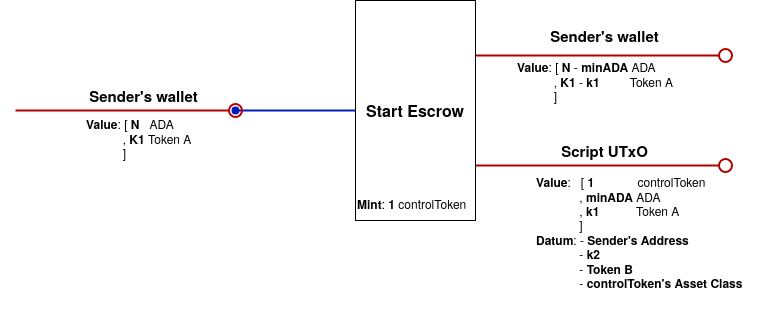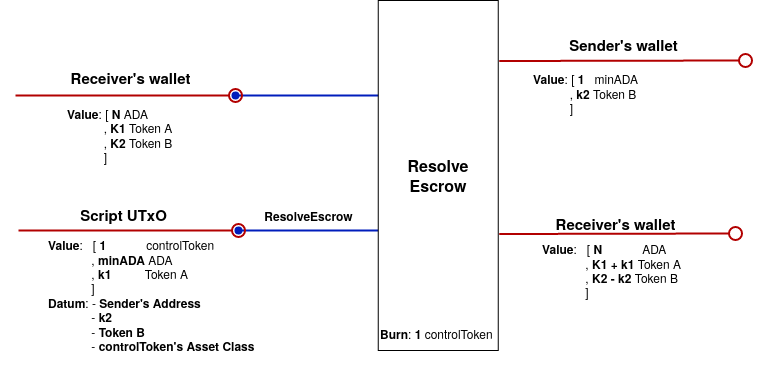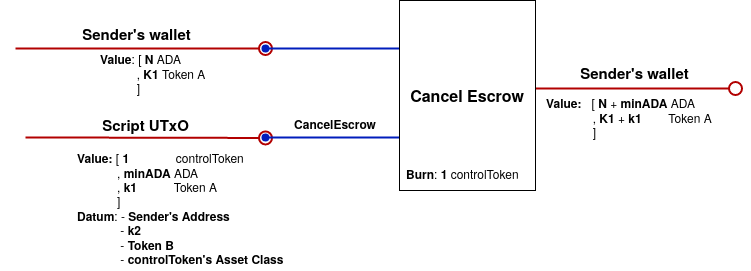1. The Example - A Simple Escrow
The example we present in this tutorial is a well known problem where smart contracts are a great solution. It’s about exchanging tokens between two users.
1.1. The Problem
Alice and Bob want to exchange tokens. Alice will pay k1 amount of A
tokens and receive k2 amount of B tokens from Bob. If Alice sends
the tokens directly to Bob’s wallet, then there is no certainty that she
will receive the corresponding payment. Alice should trust Bob after sending her
tokens.
A solution that doesn’t depend on trusting the users must be found.
1.2. How to solve it
A third trusted party can be involved. Instead of paying directly to Bob’s wallet, Alice locks her tokens into a smart contract and specifies what tokens and how many of them she wants to receive. The smart contract ensures that Bob will receive his tokens only if he pays the corresponding to Alice.
From now on, we’ll call the sender to the user that starts an escrow (Alice), and the other user (Bob), who ends an escrow by receiving the locked tokens and sending back the corresponding payment, will be called the receiver.
We’ll consider three operations:
Start: the sender starts the escrow by locking the funds and setting the information about the payment to be received.
Resolve: the receiver gets the locked funds and pays the corresponding tokens to the sender, finishing the escrow.
Cancel: the sender cancels the escrow getting back the locked tokens.
1.3. eUTxO-model-based solution
An easy solution can be implemented with Plutus scripts. The sender pays the desired value to a script, specifying all the necessary information:
Receiver’s address
RA.Sender’s address
SA.Asset Class of token to receive
B.Amount of tokens to receive
k2.
Thus, the validator can express that if a receiver wants to spend the script utxo,
the transaction must be signed by a wallet with address RA, and it must include
a payment of k2 tokens B to the address SA.
There are several design options for storing the information in a script. We choose to set the receiver’s address as a parameter of the script, and the rest of the escrow information in the datum. This is an arbitrary decision given that all the information could be located in the parameter (none of the operations need to change it), as well in the datum. We just want to show in the example how to deal with a parameterized validator and read/write datums. A consequence of this decision is that escrows with same receiver address will share the same script address.
In addition to the escrow script, we implement a minting policy for checking that all the information stored in the datum is well-formed at the start of a new escrow. Every “valid” escrow script-utxo must contain in the value the result of this minting policy, that we call control token. It is burned when escrow is resolved or cancelled.
1.3.1. Operations
Start. Sender submits a transaction paying to the script k1 tokens A,
and specifies in the datum the address where they want to receive the payment, together
with payment information (amount and asset class).
In addition to that, the value includes the min amount of ADA and the control token.
The datum also includes the asset class of the control token.
The Receiver’s address is fixed in the script address (given that it’s the validator parameter).

Resolve. Receiver submits a transaction spending the script-utxo and paying to
the Sender (whose address is specified in the datum) k2 tokens B.
The control token is burned.

Cancel. Sender submits a transaction spending the script-utxo. The control token is burned.

1.4. More details
The reader will find a more detailed explanation of requirements and design of this Escrow Decentralized Application on: